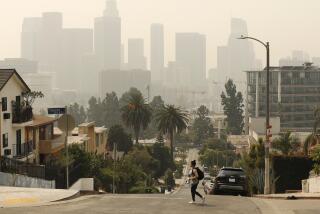Don’t Smoke at Home, EPA Urges Parents
- Share via
WASHINGTON — Laying down recommendations with potentially far-reaching effects, the Environmental Protection Agency Wednesday urged parents of young children not to smoke in their homes and outlined steps that employers should take to protect workers from the “serious and substantial” health risks of second-hand tobacco smoke.
“The EPA firmly believes that the scientific evidence is sufficient to warrant actions to protect nonsmokers from involuntary exposure to second-hand smoke,” EPA Administrator Carol Browner told a House subcommittee on health and the environment. As a result, Browner said, her agency will seek to get out a simple message: “Please help us protect children from cigarette smoking.”
In a pamphlet released Wednesday, the EPA warned that children exposed to secondhand tobacco smoke are more likely to suffer lower respiratory tract infections such as pneumonia and bronchitis, to have reduced lung function and to develop a buildup of fluid in the middle ear, a leading cause of ear infections. The EPA estimates that passive smoke inhalation is responsible for 150,000 to 300,000 cases of pneumonia and bronchitis annually in children under 18 months of age, whose developing lungs are particularly sensitive. Between 7,500 and 15,000 of those cases result in hospitalization.
In addition, the agency said that secondhand smoke is responsible for 3,000 lung cancer deaths each year among nonsmokers in the United States.
“This is one case where individual actions make a difference,” Browner told lawmakers.
Browner and the chairman of the EPA’s Scientific Advisory Board defended the EPA’s findings, released in January, against criticism from the tobacco industry and its allies, noting that the EPA had reached its conclusions during the George Bush Administration. Last month, several major tobacco growers filed suit against the EPA, claiming that its scientists used faulty statistical methods and disregarded contradictory evidence in drawing its conclusions. On Wednesday, the EPA filed a motion in court to dismiss the tobacco industry suit.
“We absolutely believe we will prevail,” Browner said.
Meanwhile, cities like Los Angeles, responding in part to the EPA’s findings, are moving to implement smoking bans in restaurants and public buildings.
Browner’s comments mark the opening of an EPA campaign to publicize its findings on secondhand smoke. The EPA, which has no formal powers to regulate indoor air pollution, released a pamphlet titled “Second-Hand Smoke: What You Can Do About Second-Hand Smoke as Parents, Decision-Makers and Building Occupants.”
But while the EPA’s powers are limited to conducting such educational campaigns, the agency’s conclusion that secondhand tobacco smoke is a human carcinogen has caused far-reaching ripples throughout the nation’s gathering spots and workplaces. Fearing litigation from workers, patrons and citizens, businesses and municipalities have rushed since January to ban or limit smoking on their premises.
The pamphlet released Wednesday outlines standards for employers and public establishments related to smoking. The EPA recommends, for example, that if smoking is permitted in the workplace, air from a smoking room should be vented directly to the outside by an exhaust fan, rather than recirculated among nonsmokers. In addition, it urges employers to support smoking cessation programs for the one in four American adults who continues to smoke.
Rep. Henry A. Waxman, (D-Los Angeles), chairman of the House Energy and Commerce subcommittee on health and environment, said Wednesday that he will introduce legislation to banish smoking from all buildings open to the public except in designated, ventilated smoking rooms.
“Smokers do not have the right to jeopardize the health of nonsmokers, particularly children,” Waxman said Wednesday.
He said that he will introduce his bill sometime next week. On Wednesday, his proposal won endorsements from the American Medical Assn., the American Academy of Pediatrics, the American Lung Assn., the American Cancer Society and the Building Owners and Management Assn.
“While society has an attitude that smokers should be able to do what they want to themselves,” Waxman said in an interview, “I don’t think anybody would defend the rights of smokers to do harm to children.”
The EPA’s campaign urges citizens to work to pass state laws and community ordinances that would limit smoking in public places, and experts said that the EPA findings are likely to accelerate an already well-established trend.
More to Read
Sign up for Essential California
The most important California stories and recommendations in your inbox every morning.
You may occasionally receive promotional content from the Los Angeles Times.











